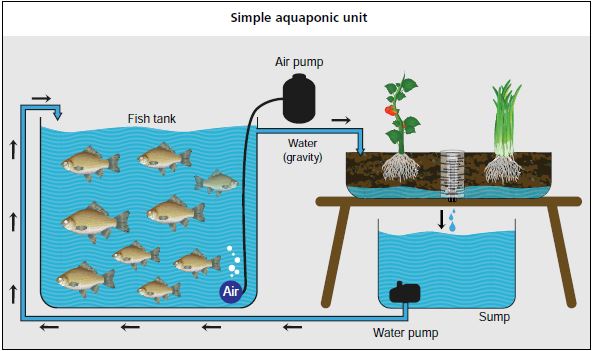Aquaponics quick-reference handout
Note: The section below reproduces the chapter summaries from the FAO aquaponic publication (see citation below). It is intended to be a short and easy-to-reproduce supplement, envisioned for use in education, extension and outreach applications and is designed to be provided to students, workers and farmers.
The full technical paper can be found at: www.fao.org/publications/en/
Somerville, C., Cohen, M., Pantanella, E., Stankus, A. & Lovatelli, A. 2014. Small-scale aquaponic food production. Integrated fish and plant farming. FAO Fisheries and Aquaculture Technical Paper. No. 589. Rome, FAO. 262 pp.
INTRODUCTION TO AQUAPONICS
Aquaponics is the integration of recirculating aquaculture system (RAS) and hydroponics in one production system. In an aquaponic unit, water from the fish tank cycles through filters, plant grow beds and then back to the fish. In the filters the water is cleaned from the fish wastes by a mechanical filter that removes the solid part, and a biofilter that processes the dissolved wastes. The biofilter provides a location for bacteria to convert ammonia, which is toxic for fish, into nitrate, a more accessible nutrient for plants. This process is called nitrification. As the water (containing nitrate and other nutrients) travels through plant grow beds the plants uptake these nutrients, and finally the water returns to the fish tank purified. This process allows the fish, plants, and bacteria to thrive symbiotically and to work together to create a healthy growing environment for each other, provided that the system is properly balanced. Although the production of fish and vegetables is the most visible output of aquaponic units, it is essential to understand that aquaponics is the management of a complete ecosystem that includes three major groups of organisms: fish, plants and bacteria.
In aquaponics, the aquaculture effluent is diverted through plant beds and not released to the environment, while at the same time the nutrients for the plants are supplied from a sustainable, cost-effective and non-chemical source. This integration removes ome of the unsustainable factors of running aquaculture and hydroponic systems independently. Beyond the benefits derived by this integration, aquaponics has shown that its plant and fish productions are comparable with hydroponics and RASS. Aquaponics can be much more productive and economically feasible in certain situations, especially where land and water are limited. However, aquaponics is complicated and requires substantial start-up costs. The increased production must compensate for the higher investment costs needed to integrate the two systems. Before committing to a large or expensive system, a full business plan considering economic, environmental, social and logistical aspects should be conducted.
